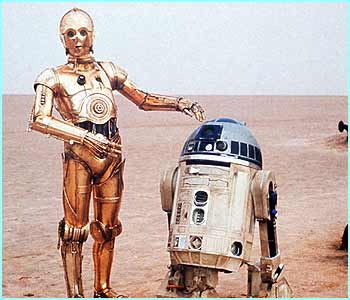A Brief History of Science Fiction Film Music
References, Links, and Works Cited
Created by Jessica Rooney
Last updated 5/1/06


Star Wars: A New Hope (1977)
The Leitmotif for Luke Skywalker
Luke Skywalker’s leitmotif proclaims his coming-of-age as the central focus of the narrative. This is established immediately at the start of the film, with the use of Luke’s leitmotif as the title theme. Even if the audience does not later consciously recognize that Luke’s theme is the same as the one where the film opened, the importance of his character is unconsciously perceived when the ear recognizes the same melody existing as both the heroic title theme and the more subtle theme for Luke’s introduction.
When Williams was creating Luke’s leitmotif, he said he wanted to reflect the “brassy, bold, masculine, and noble qualities” he saw in the character (Lerner 99). According, the leitmotif relies on martial duple rhythm, melodies played by trumpet, and leaping, disjunct melodic shape (Lerner 99). These musical techniques achieve William’s desired effects easily because they are already are connected in the audience’s mind with masculinity in music, found in other forms such as military marches, for example.
Despite this initial proclamation of Luke’s importance, the leitmotif immediately drops down to a more subtle level and becomes one of the most heavily developed leitmotifs in the film. After the original appearance in the opening title, Luke’s leitmotif is heard when Luke first appears in his home on Tatooine. The melody is carried by French horns, the tempo dropped to a slower speed and rhythmically smoother. This gives the music a yearning quality, speaking of promise and innocence, which immediate creates an emotional draw to audience.
Luke’s theme continues to develop as his leitmotif is heard in different forms throughout his journey. As time passes the melody becomes shorter, relying on shorter rhythms and brighter instrumentation, making Luke seem familiar and youthful to the audience. For example, when Luke needs to sell his landspeeder, the use of woodwinds makes him seem impatient and “immature and whiny” (Lerner 100). The music does not reach the same feeling as the opening title until Luke rescues Leia and kisses her as they are escaping the Imperial troopers. Like the title menu, the melody is reverted back to the trumpets, giving the theme a martial, triumphant tone. This helps to build audience excitement, giving them a glimpse at Luke’s true potential as a man for the first time. After this scene the leitmotif regresses slightly as it moves back to lower tones and less triumphant rhythms, but when Luke destroys the Death Star his theme is heard as “building, sequencing, ultimately climaxing” to the full realization of the leitmotif, which “announce[s] a significant step towards Luke’s achievement of…manhood” (Lerner 101).
